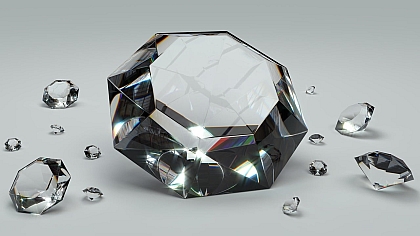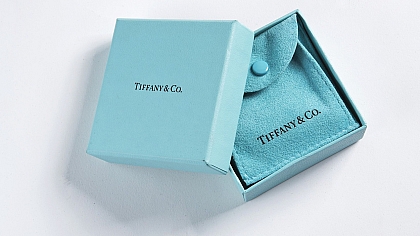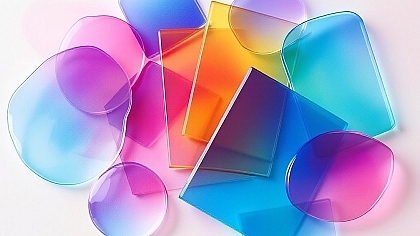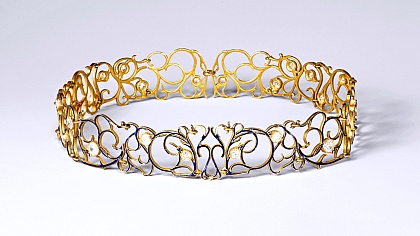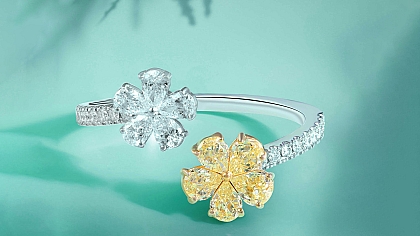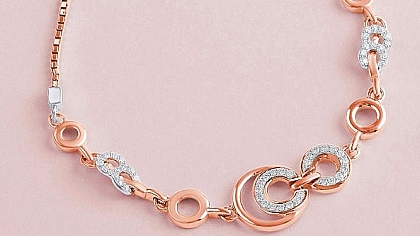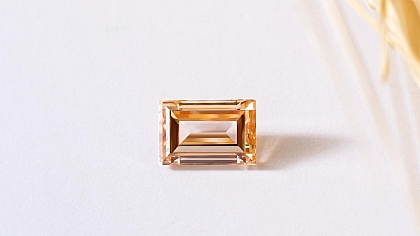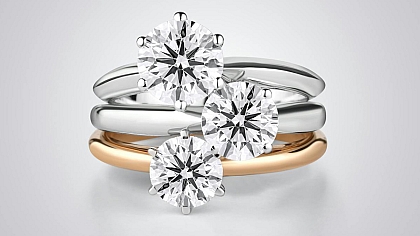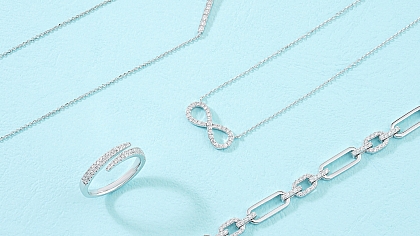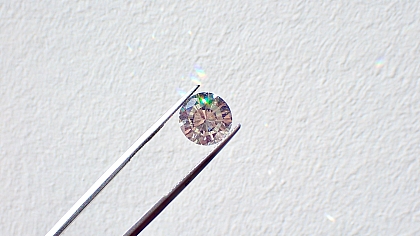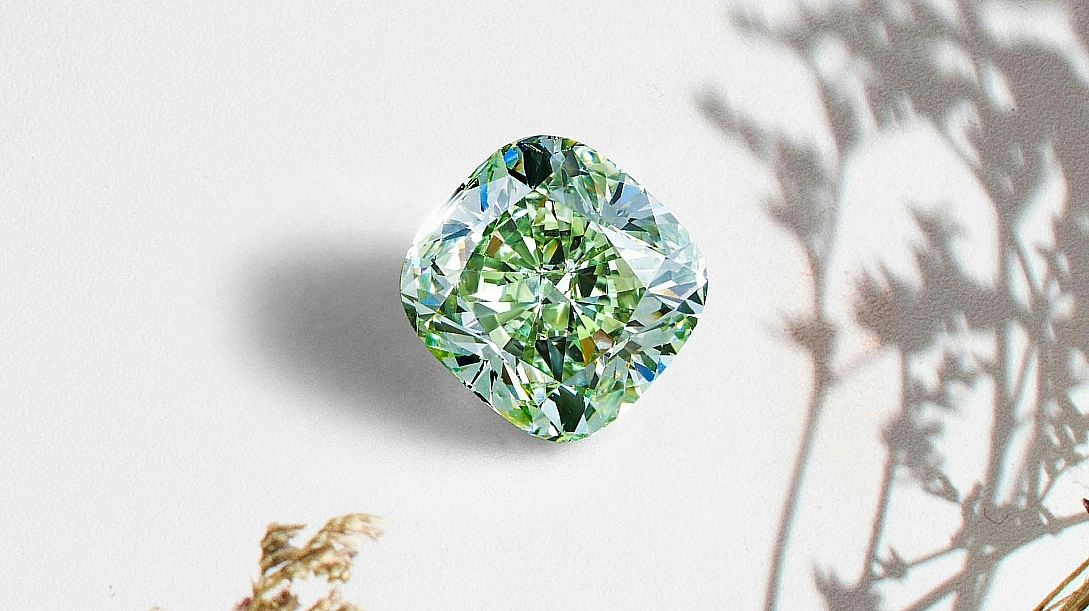
The Science of Gemstones Part 1: What Makes Them Sparkle?
Gemstones have fascinated humans for millennia, captivating us with their vibrant colours, remarkable clarity, and, above all, their enchanting sparkle. This sparkle, which can range from a subtle glimmer to a dazzling brilliance, is what often sets gemstones apart from ordinary stones and makes them highly prized in jewellery.
Understanding the science behind the sparkle of gemstones not only enhances our appreciation of these natural wonders but also informs us about their value and beauty. From the way light interacts with their internal structure to the artistry of their cut, the factors contributing to a gemstone’s sparkle are both complex and fascinating.
In this guide, we delve into the intricate world of gemstones, exploring the geological processes that form them, the optical principles that give them their brilliance, and the craftsmanship that enhances their natural beauty. By examining the scientific principles and artistic techniques that make gemstones sparkle, we can better appreciate these precious stones and the effort that goes into creating exquisite jewellery.
Whether you are a gemstone enthusiast, a jewellery aficionado, or simply curious about the science behind the sparkle, this guide will provide a comprehensive understanding of what makes these gems truly shine.
The Formation of Gemstones
The journey of a gemstone from deep within the Earth to a sparkling jewel in a piece of jewellery is a fascinating tale of geological processes and natural phenomena. Understanding the formation of gemstones helps us appreciate their rarity and beauty, as well as the unique characteristics that contribute to their sparkle.
Geological Processes
Gemstones are formed under specific conditions of temperature, pressure, and chemical environment. These conditions typically occur deep within the Earth's crust or mantle, often over millions or even billions of years. The main geological processes that lead to the formation of gemstones include:
-
Igneous Processes: Gemstones such as diamonds, sapphires, and garnets form from magma or lava. As molten rock cools and crystallizes, these gemstones can develop under high pressure and temperature conditions.
-
Metamorphic Processes: Some gemstones, like emeralds and rubies, are formed through metamorphism, which involves the transformation of existing rocks due to extreme heat and pressure. This process alters the mineral composition and structure, resulting in the formation of new gemstones.
-
Sedimentary Processes: Gemstones such as opals and certain types of quartz are formed in sedimentary environments. These gemstones develop through the deposition and compaction of mineral-rich water or sediments over long periods.
-
Hydrothermal Processes: Gemstones like topaz and tourmaline can form in hydrothermal veins. These veins are created by hot, mineral-rich water flowing through cracks and cavities in rocks, depositing crystals as the water cools and evaporates.
Types of Gemstones and Their Origins
Different types of gemstones are associated with specific geological environments and processes. Here are some examples of popular gemstones and their origins:
-
Diamonds: Formed in the Earth's mantle at depths of around 150 to 200 kilometres, diamonds are brought to the surface through volcanic eruptions that create kimberlite and lamproite pipes.
-
Emeralds: Typically found in metamorphic rocks, emeralds form in hydrothermal veins and pegmatites, often in association with minerals like quartz and feldspar.
-
Rubies and Sapphires: Both rubies and sapphires are varieties of the mineral corundum. They form in metamorphic rocks, such as marble and gneiss, as well as in igneous rocks like basalt.
-
Opals: Formed in sedimentary environments, opals develop from silica-rich solutions that fill cavities and cracks in rocks. Over time, the silica particles settle and form the characteristic play-of-colour seen in opals.
Crystallization and Mineral Composition
The crystallization process plays a crucial role in the formation of gemstones. As minerals cool and solidify, they arrange themselves into specific crystal structures. The internal arrangement of atoms within these crystals determines many of the gemstone's physical properties, including its optical characteristics and potential for sparkle.
-
Crystal Systems: Gemstones crystallize in various crystal systems, such as cubic (diamond), hexagonal (emerald), and trigonal (ruby and sapphire). The symmetry and structure of these systems influence the way light interacts with the gemstone.
-
Mineral Composition: The chemical composition of a gemstone affects its colour, hardness, and other properties. For example, the presence of trace elements like chromium can give emeralds their green colour, while iron and titanium can create blue hues in sapphires.
Understanding the formation of gemstones provides a foundation for appreciating their natural beauty and rarity. The geological processes that create these precious stones are as complex and varied as the gemstones themselves, each with a unique story that adds to its allure.
The Role of Light in Gemstone Sparkle
The captivating sparkle of a gemstone is primarily due to the interaction of light with its internal structure. Understanding how light behaves when it enters, travels through, and exits a gemstone is key to appreciating what makes these jewels truly shine. Stay with us as we go into the principles of light behaviour, including refraction, reflection, and dispersion, that contribute to the brilliance and fire of gemstones.
Interaction of Light with Gemstones
When light encounters a gemstone, several phenomena occur that influence its appearance:
- Absorption: Some wavelengths of light are absorbed by the gemstone, contributing to its colour.
- Transmission: Light that passes through the gemstone without being absorbed affects its transparency and clarity.
- Reflection: Light reflecting off the surface or internal facets of the gemstone creates sparkle and brilliance.
- Refraction: The bending of light as it enters and exits the gemstone affects how light is dispersed within the stone.
Refraction and Reflection
The refractive index (RI) of a gemstone measures how much light is bent when it enters the stone. A higher RI means greater bending of light, which can enhance the gemstone's brilliance and sparkle.
-
Critical Angle and Total Internal Reflection: When light enters a gemstone at an angle greater than its critical angle, it undergoes total internal reflection. This means the light is trapped within the stone, bouncing off internal facets and contributing to its brilliance. Diamonds, with a high RI, exhibit significant total internal reflection, which is a key factor in their sparkle.
-
Faceting and Reflection: The way a gemstone is cut, specifically how its facets are arranged, significantly affects how light is reflected within the stone. Well-cut facets act as mirrors, reflecting light back to the observer and creating a dazzling sparkle.
Dispersion and Fire
Dispersion, also known as "fire," is the separation of white light into its component colours (spectrum) as it passes through a gemstone. This phenomenon creates the flashes of rainbow colours seen in some gemstones.
-
High Dispersion Gemstones: Gemstones with a high dispersion value, such as diamonds, exhibit more fire. The precise cutting of a gemstone enhances this effect by maximizing the angles at which light is dispersed.
-
Coloured Gemstones: While dispersion is most noticeable in diamonds, it can also be observed in coloured gemstones. For example, the dispersion in a ruby can contribute to its inner fire and depth of colour.
Brilliance and Scintillation
Brilliance and scintillation are crucial aspects of a gemstone's sparkle:
-
Brilliance: Refers to the overall amount of white light reflected from the surface and internal facets of the gemstone. It is largely influenced by the gemstone's RI and the quality of the cut.
-
Scintillation: Describes the flashes of light that occur when a gemstone is moved. This "sparkling" effect is enhanced by well-proportioned and well-polished facets.
The Science Behind Specific Gemstone Sparkle
Different gemstones exhibit unique sparkle characteristics based on their optical properties and cut:
-
Diamond: Known for its exceptional brilliance and fire, a diamond's sparkle is maximized through precise cutting, such as the round brilliant cut, which enhances total internal reflection and dispersion.
-
Sapphire: While sapphires have a lower RI than diamonds, their sparkle is still significant. The cutting style, such as the step cut or mixed cut, plays a vital role in optimizing their brilliance.
-
Emerald: Emeralds, with their lower RI and characteristic inclusions, rely on the skilful arrangement of facets in an emerald cut to enhance their unique internal glow and reduce the appearance of inclusions.
The interaction of light with gemstones is a complex interplay of optical phenomena that can be meticulously controlled and enhanced by expert cutting. The way light refracts, reflects, and disperses within a gemstone creates the mesmerizing sparkle that captivates and enchants us.
The Importance of Cut and Faceting
The cut and faceting of a gemstone are crucial factors that determine its overall sparkle and brilliance. A well-executed cut can transform a rough gemstone into a dazzling jewel, maximizing its interaction with light and enhancing its natural beauty. Read on to find out how different cuts and facet arrangements affect a gemstone's sparkle, highlighting the science and artistry involved in the cutting process.
How Cut Affects Sparkle
The cut of a gemstone refers to how it is shaped and faceted to enhance its optical properties. A well-cut gemstone reflects more light internally and externally, increasing its brilliance and sparkle. Conversely, a poorly cut gemstone may appear dull or lacklustre, even if it has excellent colour and clarity.
- Proportions: The proportions of a gemstone, including the depth, table size, and pavilion angle, significantly impact how light travels through the stone. Ideal proportions allow light to enter the gemstone, reflect off the internal facets, and return to the viewer's eye, creating maximum brilliance.
- Symmetry: Symmetrical facets ensure that light is evenly distributed throughout the gemstone, enhancing its sparkle. Asymmetrical cuts can cause light leakage, reducing the stone's overall brilliance.
- Polish: A high-quality polish on the gemstone's surface minimizes light scattering and enhances its reflective properties. Poor polishing can create surface irregularities that diminish sparkle.
Different Types of Gemstone Cuts
Various gemstone cuts have been developed to optimize light performance and highlight the unique qualities of each stone. Here are some of the most popular cuts and how they contribute to sparkle:
- Round Brilliant Cut: The most common and widely admired cut, especially for diamonds, the round brilliant cut features 57 or 58 facets arranged to maximize light return. This cut is designed to produce exceptional brilliance and fire, making it a popular choice for engagement rings and other fine jewellery.
- Princess Cut: This square or rectangular cut is known for its modern look and excellent light performance. The princess cut features numerous facets that create a high level of brilliance and sparkle, particularly in diamonds.
- Emerald Cut: Characterized by its rectangular shape and step-cut facets, the emerald cut emphasizes clarity and colour over brilliance. While it may not sparkle as intensely as a brilliant cut, the emerald cut's large, open facets create a unique and sophisticated sparkle.
- Cushion Cut: Combining the elegance of a round cut with the shape of a square or rectangle, the cushion cut has rounded corners and large facets that enhance the stone's brilliance and fire. This cut is often used for diamonds and coloured gemstones alike.
- Oval Cut: The oval cut offers a similar brilliance to the round brilliant cut but with an elongated shape that can make the stone appear larger. Its symmetrical design allows for significant light reflection and sparkle.
- Marquise-Cut: This elongated cut with pointed ends creates a distinctive and dramatic look. The marquise cut maximizes carat weight and offers excellent light performance when properly faceted.
- Pear Cut: Combining the round and marquise cuts, the pear cut features a rounded end and a pointed tip. This unique shape can produce significant sparkle, especially when the stone is set to enhance its light-reflective properties.
- Asscher Cut: Similar to the emerald cut but with a square shape, the Asscher cut features step-cut facets that create a hall-of-mirrors effect. This cut emphasizes clarity and colour, offering a vintage-inspired sparkle.
The Science Behind Facet Arrangements
The arrangement and number of facets on a gemstone determine how light is reflected and refracted within the stone. Here are key aspects of facet arrangements that influence sparkle:
- Pavilion and Crown: The pavilion (lower part) and crown (upper part) of a gemstone each have facets that play distinct roles in light performance. The pavilion facets reflect light back through the crown, enhancing brilliance and fire.
- Girdle: The girdle is the thin band that separates the crown from the pavilion. A well-proportioned girdle prevents light leakage and ensures the stone's durability.
- Table: The table is the flat, topmost facet of the gemstone. A large table allows more light to enter the stone, while a smaller table concentrates light within, affecting brilliance and sparkle.
- Culet: The culet is the small facet at the bottom of the gemstone. A well-cut culet can prevent light leakage and enhance the overall sparkle of the stone.
Craftsmanship and Technology
The artistry and precision of gemstone cutting have evolved significantly with advancements in technology. Modern techniques and tools allow for greater accuracy and consistency in facet arrangements, optimizing the sparkle of each gemstone. Laser cutting and computer-aided design (CAD) have revolutionized the industry, enabling cutters to achieve ideal proportions and symmetry with remarkable precision.
The importance of cut and faceting in a gemstone cannot be overstated. These elements transform a raw stone into a brilliant jewel, maximizing its interaction with light and enhancing its natural beauty. By understanding the science and artistry behind gemstone cuts, you can better appreciate the craftsmanship that goes into creating sparkling gemstones.
The Importance of Cut and Faceting
The cut and faceting of a gemstone are crucial factors that determine its overall sparkle and brilliance. A well-executed cut can transform a rough gemstone into a dazzling jewel, maximizing its interaction with light and enhancing its natural beauty.
How Cut Affects Sparkle
The cut of a gemstone refers to how it is shaped and faceted to enhance its optical properties. A well-cut gemstone reflects more light internally and externally, increasing its brilliance and sparkle. Conversely, a poorly cut gemstone may appear dull or lacklustre, even if it has excellent colour and clarity.
- Proportions: The proportions of a gemstone, including the depth, table size, and pavilion angle, significantly impact how light travels through the stone. Ideal proportions allow light to enter the gemstone, reflect off the internal facets, and return to the viewer's eye, creating maximum brilliance.
- Symmetry: Symmetrical facets ensure that light is evenly distributed throughout the gemstone, enhancing its sparkle. Asymmetrical cuts can cause light leakage, reducing the stone's overall brilliance.
- Polish: A high-quality polish on the gemstone's surface minimizes light scattering and enhances its reflective properties. Poor polishing can create surface irregularities that diminish sparkle.
Different Types of Gemstone Cuts
Various gemstone cuts have been developed to optimize light performance and highlight the unique qualities of each stone. Here are some of the most popular cuts and how they contribute to sparkle:
- Round Brilliant Cut: The most common and widely admired cut, especially for diamonds, the round brilliant cut features 57 or 58 facets arranged to maximize light return. This cut is designed to produce exceptional brilliance and fire, making it a popular choice for engagement rings and other fine jewellery.
- Princess Cut: This square or rectangular cut is known for its modern look and excellent light performance. The princess cut features numerous facets that create a high level of brilliance and sparkle, particularly in diamonds.
- Emerald Cut: Characterized by its rectangular shape and step-cut facets, the emerald cut emphasizes clarity and colour over brilliance. While it may not sparkle as intensely as a brilliant cut, the emerald cut's large, open facets create a unique and sophisticated sparkle.
- Cushion Cut: Combining the elegance of a round cut with the shape of a square or rectangle, the cushion cut has rounded corners and large facets that enhance the stone's brilliance and fire. This cut is often used for diamonds and coloured gemstones alike.
- Oval Cut: The oval cut offers a similar brilliance to the round brilliant cut but with an elongated shape that can make the stone appear larger. Its symmetrical design allows for significant light reflection and sparkle.
- Marquise-Cut: This elongated cut with pointed ends creates a distinctive and dramatic look. The marquise cut maximizes carat weight and offers excellent light performance when properly faceted.
- Pear Cut: Combining the round and marquise cuts, the pear cut features a rounded end and a pointed tip. This unique shape can produce significant sparkle, especially when the stone is set to enhance its light-reflective properties.
- Asscher Cut: Similar to the emerald cut but with a square shape, the Asscher cut features step-cut facets that create a hall-of-mirrors effect. This cut emphasizes clarity and colour, offering a vintage-inspired sparkle.
The Science Behind Facet Arrangements
The arrangement and number of facets on a gemstone determine how light is reflected and refracted within the stone. Here are key aspects of facet arrangements that influence sparkle:
- Pavilion and Crown: The pavilion (lower part) and crown (upper part) of a gemstone each have facets that play distinct roles in light performance. The pavilion facets reflect light back through the crown, enhancing brilliance and fire.
- Girdle: The girdle is the thin band that separates the crown from the pavilion. A well-proportioned girdle prevents light leakage and ensures the stone's durability.
- Table: The table is the flat, topmost facet of the gemstone. A large table allows more light to enter the stone, while a smaller table concentrates light within, affecting brilliance and sparkle.
- Culet: The culet is the small facet at the bottom of the gemstone. A well-cut culet can prevent light leakage and enhance the overall sparkle of the stone.
Craftsmanship and Technology
The artistry and precision of gemstone cutting have evolved significantly with advancements in technology. Modern techniques and tools allow for greater accuracy and consistency in facet arrangements, optimizing the sparkle of each gemstone. Laser cutting and computer-aided design (CAD) have revolutionized the industry, enabling cutters to achieve ideal proportions and symmetry with remarkable precision.
The importance of cut and faceting in a gemstone cannot be overstated. These elements transform a raw stone into a brilliant jewel, maximizing its interaction with light and enhancing its natural beauty. By understanding the science and artistry behind gemstone cuts, you can better appreciate the craftsmanship that goes into creating sparkling gemstones.
Optical Phenomena in Gemstones
Gemstones often exhibit unique optical phenomena that enhance their allure and mystique. These phenomena occur due to specific structural and compositional characteristics within the gemstone, interacting with light in distinct ways. Understanding these effects can deepen our appreciation of gemstones and highlight the remarkable diversity in their appearances. We will uncover some of the most fascinating optical phenomena in gemstones, including chatoyancy, asterism, and opalescence.
Chatoyancy (Cat's Eye Effect)
Chatoyancy, or the cat's eye effect, is a striking optical phenomenon seen in certain gemstones, where a narrow band of light appears to move across the surface of the stone, resembling a cat's eye.
- Cause of Chatoyancy: This effect is caused by the reflection of light off parallel needle-like inclusions or fibrous structures within the gemstone. Common minerals exhibiting chatoyancy include chrysoberyl, tiger's eye, and tourmaline.
- Enhancing Chatoyancy: Gemstones displaying chatoyancy are typically cut en cabochon (with a smooth, rounded surface) to maximize the visibility of the cat's eye effect. Proper orientation and cutting techniques are crucial to achieving the desired visual impact.
- Applications in Jewellery: Chatoyant gemstones are often used in rings and pendants, where their unique light effect can be prominently displayed and appreciated.
Asterism (Star Effect)
Asterism is another captivating optical phenomenon, where star-like patterns of light appear on the surface of a gemstone. These stars usually have four, six, or twelve rays and are most commonly seen in cabochon-cut stones.
- Cause of Asterism: This effect is caused by the reflection of light off inclusions of rutile needles arranged in a specific orientation within the gemstone. Gemstones known for exhibiting asterism include star sapphires, star rubies, and certain garnets.
- Enhancing Asterism: Like chatoyant stones, star gemstones are cut en cabochon to display the star effect most effectively. The angle of the cut relative to the rutile inclusions determines the clarity and prominence of the star.
- Applications in Jewellery: Star gemstones are highly prized in jewellery for their rarity and unique appearance. They are often set in rings, brooches, and pendants to highlight the star effect.
Opalescence and Play-of-Colour
Opalescence, also known as play-of-colour, is a mesmerizing optical phenomenon observed in opals, where flashes of vibrant colours appear to shift and change as the stone is viewed from different angles.
- Cause of Opalescence: This effect is caused by the diffraction of light through the microscopic silica spheres that make up the opal. The size and arrangement of these spheres create the characteristic play-of-colour, with larger spheres producing red and orange colours, and smaller spheres producing blue and green colours.
- Types of Opal: Different types of opals exhibit varying degrees of opalescence. Black opals and white opals are particularly valued for their intense play of colour, while fire opals may display more subtle flashes of colour.
- Enhancing Opalescence: The cutting and polishing of opals are crucial to maximizing their play of colour. Cabochon cuts are typically used to enhance the visibility of this phenomenon.
- Applications in Jewellery: Opals are used in a wide range of jewellery pieces, including rings, necklaces, earrings, and bracelets. Their unique and dynamic play-of-colour makes them highly desirable and often the centrepiece of the design.
Iridescence
Iridescence is a phenomenon where a gemstone displays a spectrum of colours that change with the angle of observation and lighting. This effect is similar to the colours seen in a soap bubble or oil slick.
- Cause of Iridescence: This effect is caused by the interference of light waves reflected from the thin layers or structural imperfections within the gemstone. Examples of gemstones exhibiting iridescence include labradorite, moonstone, and certain types of pearls.
- Enhancing Iridescence: Proper cutting and polishing can enhance the iridescent effect. Gemstones with iridescence are often cut to highlight the angle at which the effect is most prominent.
- Applications in Jewellery: Iridescent gemstones are popular in all forms of jewellery, from statement pieces to everyday wear. Their shifting colours add a dynamic and eye-catching element to the design.
Schiller Effect (Labradorescence)
The Schiller effect, also known as labradorescence, is a stunning optical phenomenon seen in labradorite, where metallic-like flashes of colour shimmer across the gemstone’s surface.
- Cause of Schiller Effect: This effect is caused by the diffraction of light within the layers of feldspar minerals in the stone. The alignment of these layers creates the shimmering effect as light interacts with them.
- Enhancing Schiller Effect: The Schiller effect is most visible when labradorite is cut and polished with a flat surface, often as cabochons or beads. The orientation of the cut must align with the layers to maximize the effect.
- Applications in Jewellery: Labradorite with a strong Schiller effect is used in various types of jewellery, including rings, pendants, and earrings, where its unique visual properties can be showcased.
Adularescence
Adularescence is a soft, glowing light that appears to float just below the surface of a gemstone, commonly seen in moonstones.
- Cause of Adularescence: This effect is caused by the diffraction of light within the microstructure of the gemstone, particularly from the alternating layers of orthoclase and albite feldspar.
- Enhancing Adularescence: Moonstones are typically cut en cabochon to best display adularescence. The angle of the cut relative to the layers within the stone is critical in maximizing the phenomenon.
- Applications in Jewellery: Moonstones with strong adularescence are prized for their mystical and ethereal appearance, making them popular in rings, necklaces, and earrings.
Colour Change
Some gemstones exhibit a colour change phenomenon, where the colour of the gemstone appears to change under different lighting conditions.
- Cause of Colour Change: This effect is caused by the gemstone’s ability to absorb and reflect different wavelengths of light under varying lighting conditions. Alexandrite is the most famous gemstone that exhibits a dramatic colour change, appearing green in daylight and red under incandescent light.
- Enhancing Colour Change: Proper cutting and clarity can enhance the visibility of the colour change effect. The gemstone should be evaluated under different lighting conditions to appreciate its full range of colours.
- Applications in Jewellery: Colour-change gemstones are highly prized for their unique optical properties and are often used in rings, pendants, and earrings where their changing colours can be easily observed.
Understanding the optical phenomena in gemstones adds another layer of fascination and appreciation for these natural wonders. These effects not only enhance the beauty and uniqueness of gemstones but also highlight the intricate interplay of light and matter that makes each gemstone a remarkable creation.
Read The Science of Gemstones Part 2 to find out more about the enhancements, maintenance and purchasing factors of these brilliant gemstones.
